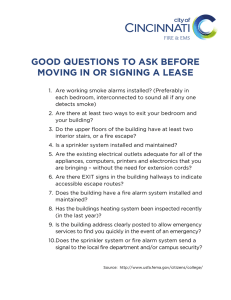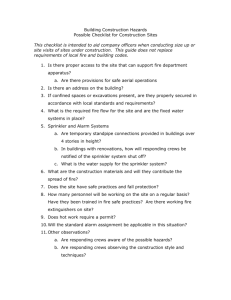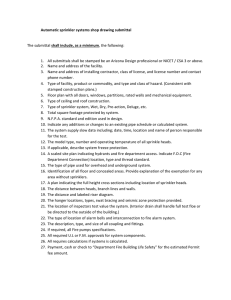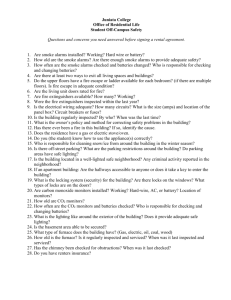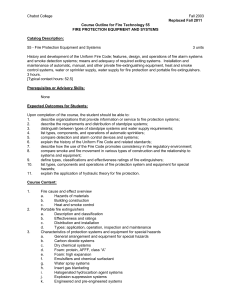No Fire Alarm Safety Plan
advertisement
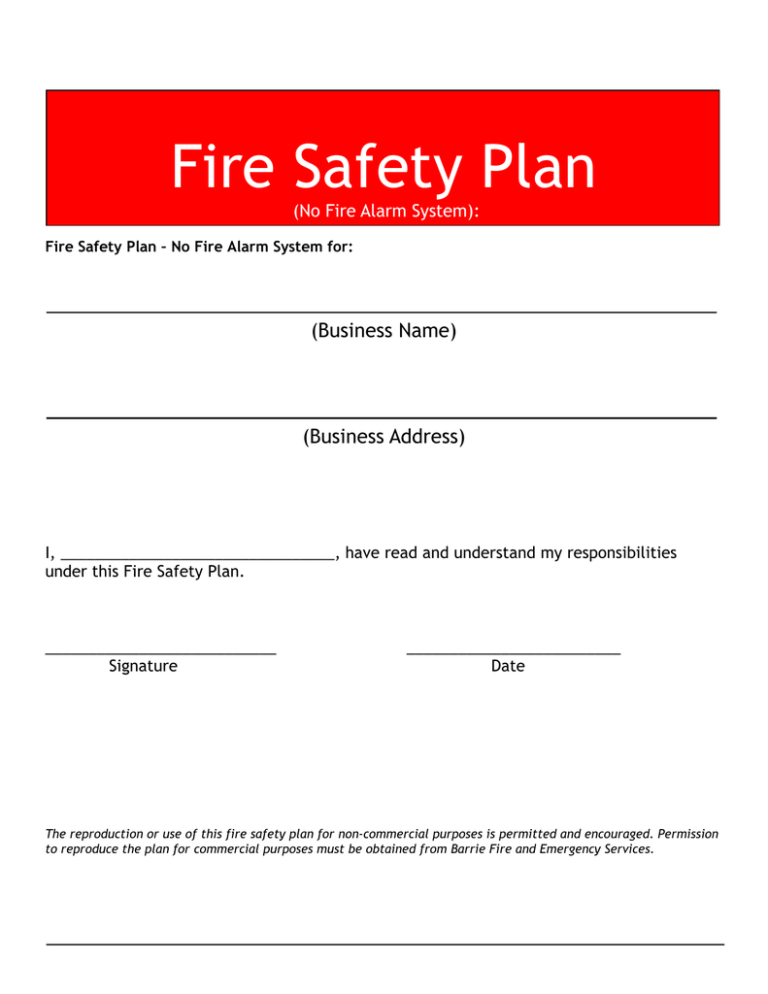
Fire Safety Plan (No Fire Alarm System): Fire Safety Plan – No Fire Alarm System for: (Business Name) (Business Address) I, ________________________________, have read and understand my responsibilities under this Fire Safety Plan. ___________________________ Signature _________________________ Date The reproduction or use of this fire safety plan for non-commercial purposes is permitted and encouraged. Permission to reproduce the plan for commercial purposes must be obtained from Barrie Fire and Emergency Services. Table of Contents Topic Part 1 Introduction Part 2 (a) Part 2 (b) Building Resources Audit Human Resources Audit Part 3 Emergency Procedures — Occupants Part 4 Emergency Procedures — Supervisors Part 5 Responsibilities of the Owner/Occupant Part 6 (a) Part 6 (b) Fire Hazards – Residential Fire Hazards — Commercial Part 7 Fire Extinguishment/Control/Confinement Part 8 Alternative Measures Part 9 Fire Drills Part 10 Maintenance Requirements of Building Fire And Life Safety Systems Part 11 Building Schematics Appendix Firewatch Procedures and Log Part 1 Introduction The Ontario Fire Code, Section 2.8 requires the implementation of a FIRE SAFETY PLAN for this building/occupancy. The plan is to be kept in the building in an approved location. The implementation of the Fire Safety Plan helps to ensure effective utilization of life safety features in a building to protect people from fire. The required Fire Safety Plan should be designed to suit the resources of each individual building or complex of buildings. It is the responsibility of the owner to ensure that the information contained within the Fire Safety Plan is accurate and complete. The Fire Code defines “OWNER” as “any person, firm or corporation controlling the property under consideration”. Consequently, owners may be managers, maintenance staff and tenant groups. The Fire Protection and Prevention Act Part VII, Section 28, states that in the case of an offence for contravention of the fire code, a corporation is liable to a fine of not more than $100,000 and an individual is liable to a fine of not more than $50,000 or imprisonment for a term of not more than one year or both. This official document is to be kept readily available at all times for use by staff and fire officials in the event of an emergency. The fire safety plan approved location is . SUBMISSION PROCEDURES At least two (2) copies of the Plan (8 ½ X 11 format) must be submitted to the Chief Fire Official. Upon approval, one copy will be returned to the author and one copy will be retained by the Fire Department. The Chief Fire Official is to be notified regarding any subsequent changes in the approved Fire Safety Plan. Part 2(a) Audit of Building Resources Checklist Occupancy Type Occupant Load When the occupant load is more than 60 persons in assembly occupancies, the owner is responsible for posting the maximum occupant load in a conspicuous location. Occupant Load: Access Designated Fire Route: No Yes Nearest Municipal Hydrant Location: Private Hydrants: No Lockbox: No Heating Natural Gas Main Gas Shut-off: No Yes (Location(s)): Yes (Location(s)): Other Electric Yes (Location(s)): Main Electrical Shut-off Location: Main Domestic Water Shut-off Location: Sprinkler System: No Yes Type: Wet Connected to the Fire Alarm System: No Location of Sprinkler Room/Shut Off Valves: Standpipe System: No Yes Location of Shutoff/Isolation Valves: Dry Yes Other Fire Department Connection: Fire Pump: No No Yes (Location(s)): Yes (Location(s): Fixed Extinguishing System for Commercial Cooking Equipment No Yes Type: (i.e. Wet Chemical, Dry Chemical, CO2) Fuel Source: Natural Gas Fuel Shut Off for Appliances: K Type (wet) Extinguisher: Electric Other Location: Location: Other Extinguishing Systems: Type(i.e. pre-action, sprinkler, halon, inergen, dry chemical): Portable Fire Extinguishers Portable Fire Extinguishers: Type(s): Refer to schematic drawings. Area/Location Protecting Emergency Lighting No Yes Location(s): Emergency Power No Yes Battery Generator Diesel Natural Gas Fuel Supply Location: Transfer Switch Location: Equipment Powered by Generator: Generator Extra Hazardous Area: Are there hazardous materials on site? No If YES, please list the material and quantity: Exits: Refer to schematics for location of exits. Yes Part 2(a) Additional Information For any additional information not already covered: Part 2(b) Audit of Human Resources Business/Building Name: Address: Unit No. Postal Code: Business Phone No. Business Owner: Address: Postal Code: Phone Number(s): After Hour Contacts (24 hour telephone numbers) Manager/Supervisor: Phone No. Employee/Title: Phone No. Employee/Title: Phone No. Other: Phone No. Building Owner: Address: Postal Code: Phone No. Sprinkler Monitoring Company: Phone No.: Part 3 Emergency Procedures for Occupants Please take the time to review this section (1 page). Emergency procedures signage will be affixed to the wall on each floor area. IN CASE OF FIRE Upon Discovery of Fire: • • • • • • Leave fire area immediately. Close all doors behind you. Alert occupants of building. Yell “FIRE”. Call Barrie Fire and Emergency Service at 9-1-1 (from a safe location). Exit the building via the nearest exit. Do not use elevators. Upon Hearing of a Fire Condition: • • • Exit the building via the nearest exit. Close doors behind you. Do not use elevator. Caution: • • If smoke is heavy in the corridor, it may be safer to stay in your area. Close door and place a wet towel or other object, i.e. jacket, sweater, etc. at the base of the door. If you encounter smoke in stairway, use an alternate exit or find refuge in nearest suite. Remain Calm No Fire Alarm System Part 4 Emergency Procedures for Supervisory Staff Please take the time to review this section (2 pages). Upon Discovery of Fire • • • • • Leave fire area immediately and close doors. Alert occupants of building. Yell “Fire”. Call 9-1-1 from a safe location. Exit the building via the nearest exit. Do not use elevators. Await the arrival of Fire Department at the main entrance. Upon Hearing of a Fire Condition • • • • • Ensure that the other occupants have been notified of the emergency conditions. Notify the Barrie Fire and Emergency Service of the emergency condition. Dial 9-1-1 and ask for Barrie Fire and Emergency Service. If it is safe to do so, supervise the evacuation of all occupants, including those requiring assistance. Upon the arrival of the firefighters, inform the fire officer of the conditions in the building and co-ordinate the efforts of the Supervisory staff with those of the Fire Department. Provide keys, fire safety plan and other vital information to the firefighters. Related Duties In general: • • • • • • Keep the doors in fire separations closed at all times. Keep access to exits and EXITS, inside and outside, clear of any obstructions at all times. Do not permit combustible materials to accumulate in quantities or locations that would constitute a fire hazard. Promptly remove all combustible waste from areas where waste is placed for disposal, if applicable. Keep access roadways, fire routes and fire department connections clear and accessible for fire department use. Maintain the fire protection equipment in good operating condition at all times. • • • • • • Participate in fire drills. Occupants’ participation should be encouraged. Have a working knowledge of the building fire and life safety systems. Ensure the building fire and life safety systems are in operating condition. Arrange for a substitute in your absence. Comply with the Ontario Fire Code. In the event of any shutdown of fire and life safety systems, notify Barrie Fire and Emergency Service and initiate alternative measures. Emergency Procedures Additional Information/Comments Examples • Industrial Spill Procedures. • Procedures for people with special needs. • Specific training requirements (ie. Lifts, carries and transfers both vertical and horizontal) for staff in care establishments. Emergency Procedures Additional Information/Comments (p.2) Part 5 Responsibilities of the Owner / Occupant Please take the time to review this section (1 page). The building owner/occupant has numerous responsibilities related to fire safety and must ensure that the following measures are enacted: • • • • • • • • • • • • • • Establishment of emergency procedures to be followed at the time of an emergency. Appointment and organization of designated supervisory staff to carry out safety duties. Instructions, in writing, for supervisory staff and other occupants so that they are aware of their responsibilities for fire safety. Holding of fire drills in accordance with the Fire Code, incorporating Emergency Procedures appropriate to the building. Control of fire hazards in the building. Maintenance of building facilities provided for safety of the occupants. Provisions of alternate measures for safety of occupants during shut down of fire protection equipment. Assuring that checks, tests and inspections as required by the Ontario Fire Code are completed on schedule and that records are retained for a minimum period of two (2) years. Post and maintain at least one (1) copy of the fire emergency procedures. Keep a copy of the approved Fire Safety Plan on the premises in an approved location. Notification of the Chief Fire Official regarding changes in the Fire Safety Plan. Ensure that the information in the Fire Safety Plan is current. Designate and train sufficient alternates to replace supervisory staff during any absence. When the occupant load is more than 60 persons in assembly occupancies, the owner is responsible for posting the maximum occupant load in a conspicuous location. Smoke Alarm Requirements in Residential Occupancies: • Smoke Alarms shall be installed in accordance with the Ontario Building Code. • Smoke alarms shall be maintained in operating condition by the owner. • Landlord shall provide a copy of the smoke alarm manufacturer’s maintenance instructions, or approved alternative, to the occupant in each rental dwelling unit. Part 6(a) Fire Hazards Please take the time to review this section (2 pages). Residential Properties To avoid fire hazards in the building, occupants must: • Never put burning materials such as cigarettes and ashes into the garbage chute. • Never dispose of flammable liquids or aerosol cans in these chutes. • Never force cartons, coat hangers, bundles of paper into the chute because it may become blocked. • Avoid unsafe cooking practices: deep fat frying, too much heat, unattended stoves, loosely hanging sleeves. • Avoid careless smoking. Never smoke in bed. • Never leave anything that may burn or cause a trip hazard in the halls, corridors and/or stairways. • Always clean out clothes dryer lint collector before and after use. • Do not use unsafe electrical appliances, frayed extension cords, over-loaded outlets or lamp wire for permanent wiring. In general, occupants should: • Know how to alarm occupants of building, know where exits are located. • Call Barrie Fire and Emergency Service immediately (9-1-1) whenever you need assistance. • Know the correct address of the building. • Notify the building owner/property management if special assistance if required in the event of an emergency. • Know procedures established to implement safe evacuation. Read and follow the manufacturers smoke alarm (and CO detector if applicable) instructions, available from building owner/property management. • Know the supervisory staff in your building. • Report any fire hazard to supervisory staff. • Know the stairwell designation and the crossover floors (if any). Part 6(b) Fire Hazards Commercial, Retail and Industrial Properties A high standard of housekeeping and building maintenance is probably the most important single factor in the prevention of fire. Listed below are some specific hazards. • Combustible material stored in non-approved areas. • Fire and smoke barrier door not operating properly or wedged open. • Improper storage of flammable liquids and gases. • Defective electrical wiring and appliances, over-fusing, and the use of extension cords as permanent wiring. • Clothes dryer lint collector full or improperly vented. • Careless use of smoking materials. • Kitchen hoods and filters not cleaned properly/grease laden. • Improper disposal of oily rags. In general, occupants should: • Know how to alarm occupants of building, know where exits are located. • Call Barrie Fire & Emergency Service immediately (9-1-1) whenever you need assistance. • Know the correct address of the building. • Notify the building/property management if special assistance is required in the event of an emergency. • Know the procedures established to implement safe evacuation. • Know the supervisory staff in your building. • Report any fire hazard to supervisory staff. • Know stairwell designation and the crossover floors (if any). Part 7 Fire Extinguishment, Control or Confinement Please take the time to review this section (1 page). In the event a small fire cannot be extinguished with the use of a portable fire extinguisher or the smoke presents a hazard for the operator, the door to the area must be closed to confine and contain the fire. Leave the fire area. Ensure that occupants have been made aware of the fire and that Barrie Fire & Emergency Service has been notified prior to an attempt to extinguish the fire. Only those persons who are trained and familiar with extinguisher operation should attempt to fight the fire. Suggested Operation of Portable Fire Extinguishers Remember the (PASS) P - Pull the safety pin A - Aim the nozzle (at the base of the flame) S - Squeeze the trigger handle (from a safe distance) S - Sweep from side to side (watch for fire restarting) Never re-hang extinguishers after use. Ensure they are properly recharged by a person that is qualified to service portable fire extinguishers and that a replacement extinguisher is provided. Keep extinguishers in a visible area without obstructions around them. Part 8 Alternative Measures for Occupant Fire Safety Please take the time to review this section (1 page). In the event of any shut-down of fire protection equipment systems or part thereof, in excess of 24 hours, the fire department shall be notified in writing. Occupants will be notified and instructions will be posted as to alternative provisions or actions to be taken in case of emergency. These provisions and actions must be acceptable to the Chief Fire Official. All attempts to minimize the impact of malfunctioning equipment will be initiated. Where portions of a sprinkler system are placed out of service, service to remaining portions must be maintained, and where necessary, the use of watchmen, bull-horns, walkie talkies, etc. will be employed to notify concerned parties of emergencies. Assistance and direction for specific situations will be sought from Barrie Fire & Emergency Service. Firewatch (See appendix for Fire Watch Duties and Log) Procedures to be followed in the event of shutdown of any part of a fire protection system are as follows: 1. Notify Barrie Fire & Emergency Service, dial (705) 728-3199 (DO NOT USE 911). Give your name, address and a description of the problem and when you expect it to be corrected. Barrie Fire & Emergency Service is to be notified in writing of shutdowns longer than 24 hours. 2. Post notices on all floors by elevators and in the lobby entrance, stating the problem, and procedures to follow in the event of an emergency. 3. Have staff of other reliable person(s) patrol the affected area(s) at least once every hour while the building is occupied. 4. Notify Barrie Fire & Emergency Service and the building occupants when repairs have been completed and systems are operational. Note: All shutdowns will be confined to as limited an area and duration as possible. Cooking operations shall be suspended until the commercial cooking fixed extinguishing system is restored. Part 9 Fire Drills Please take the time to review this section. months to ensure efficient execution of the Fire drills will be held at least once every Emergency Procedures. Fire drill records are required to be retained for a period of one year. FIRE DRILL RECORD Date: Manager/Supervisor On-Duty: Staff Present: Deficiencies Noted: General Comments: Time: Part 10 Requirements of the Ontario Fire Code Please take the time to review this section (1 page). Check/test/inspect requirements of the Ontario Fire Code: • To assist you in fulfilling your obligations, included is a list of the portions of the Fire Code that requires checks, inspections and/or tests to be conducted of the facilities. It is suggested that you read over this list and perform or have performed the necessary checks, inspections and/or tests for the items which may apply to your property. • Fire Prevention Officers may check to ensure that the necessary checks, inspections and/or tests are being done, when conducting their inspections. • This list has been prepared for purposes of convenience only. reference, the Fire Code should be consulted. For accurate Definitions for key words are as follows: Check means visual observation to ensure the device or system is in place and is not obviously damaged or obstructed Test means the operation of a device or system to ensure that it will perform in accordance with its intended operation or function Inspect means physical examination to determine that the device or system will apparently perform in accordance with its intended function It is stated in the Fire Code that records of all tests and corrective measures are required to be retained for a period of two years after they are made. General Fire Protection Systems/Equipment General Doors in fire separations shall be checked as frequently as necessary to ensure that they remain closed. Exit signs shall be clearly visible and maintained in a clean and legible condition. Internally illuminated exit signs shall be kept clearly illuminated at all times, when the building is occupied. Weekly When subject to accumulation of combustible deposits, hoods, filters and ducts shall be checked weekly and be cleaned when such deposits create an undue fire hazard. Monthly Doors in fire separations shall be inspected monthly for proper operation. Yearly Fire dampers and fire-stop flaps shall be inspected annually, or based on a schedule via contractor acceptable to the Chief Fire Official. Every chimney, flue and flue pipe shall be inspected annually and cleaned as often as necessary to keep them free from accumulations of combustible deposits. Disconnect switches for mechanical air-conditioning and ventilating systems shall be inspected annually to establish that the system can be shut down. Spark arresters shall be cleaned annually or more frequently where accumulations of debris will adversely affect operations. Burnt-out arresters shall be repaired or replaced. Responsibility Portable Fire Extinguishers General Each portable extinguisher shall have a tag securely attached to it showing the maintenance or recharge date, the servicing agency and the signature of the person who performed the service. A permanent record containing the maintenance date, the examiner’s name and a description of any work or hydrostatic testing carried out shall be prepared and maintained for each portable extinguisher. All extinguishers shall be recharged after use or as indicated by an inspection or when performing maintenance. When recharging is performed, the recommendations of the manufacturer shall be followed. Monthly Portable extinguishers shall be inspected monthly. Yearly Extinguishers shall be subject to maintenance not more than one year apart or when specifically indicated by an inspection. Maintenance procedures shall include a thorough examination of the three basic elements of an extinguisher: a) mechanical parts b) extinguishing agent c) expelling means Every twelve months, pump tank water, and pump tank calcium chloride base antifreeze types of extinguishers shall be recharged with new chemicals or water, as applicable Responsibility Responsibility 5 Years Every five years, pressurized water and carbon dioxide fire extinguishers shall be hydrostatically tested. 6 Years Every six years, stored pressure extinguishers that require a 12 year hydrostatic test shall be emptied and subjected to the applicable maintenance procedures. Smoke Alarms General Ensure dwelling unit smoke alarms are maintained in operating condition. Ensure a copy of the smoke alarm manufacturer’s Maintenance instructions or approved alternative has been provided. Responsibility Standpipe Systems Monthly Hose cabinets shall be inspected monthly to ensure that the hose and equipment are in the proper position and appear to be operable. Yearly Plugs or caps on Fire Department connections shall be removed annually and the threads inspected for wear, rust or obstruction. Re-secure plugs or caps, wrench tight. If plugs or caps are missing, examine the Fire Department connections for obstructions, back flush if necessary, and replace plugs or caps. Hose valves shall be inspected annually to ensure that they are tight and that there is no water leakage into the hose. Standpipe hose shall be removed and re-racked annually and after use. Any worn gaskets in the couplings, at the hose valve and at the nozzle shall be replaced. Responsibility Sprinkler Systems (Wet) General Auxiliary drains shall be inspected as required to prevent freezing. Weekly Except for electrically supervised valves, all valves controlling water supplies to sprinklers and alarm connections shall be checked weekly to ensure that they are sealed or locked in the open position. Water supply pressure and system air or water pressure shall be checked weekly by using gauges to ensure that the system is maintained at the required operating pressure. Monthly On all sprinkler systems, an alarm test, using the alarm test connection located at the sprinkler valve, shall be performed monthly. Two Months All transmitters and water flow devices shall be tested at two month intervals. Six Months Gate-valve supervisory switches and other sprinkler system supervisory devices shall be tested at six month intervals. Responsibility Yearly Exposed sprinkler piping hangers shall be checked yearly to ensure that they are kept in good repair. Sprinkler heads shall be checked at least once per year to ensure that they are kept in good repair. Sprinkler heads shall be checked at least once per year to ensure that they are free from damage, corrosion, grease, dust, paint, or whitewash. They shall be replaced where necessary as a result of such conditions. On wet sprinkler systems, water-flow alarm test using the most hydraulically remote test connection, shall be performed annually. Sprinkler system water pressure shall be tested annually or after any sprinkler system control valve has been operated, with the main drain valve fully open, to ensure that there are no obstructions or deterioration of the main water supply. Plugs or caps on Fire Department connections shall be removed annually and the threads inspected of wear, rust or obstruction. Re-secure plugs or caps, wrench tight. If plugs or caps are missing, examine the Fire Department connection for obstructions, back flush if necessary and replace plugs or caps. Responsibility Sprinkler Systems (Dry) General Auxiliary drains shall be inspected as required to prevent freezing. Dry-pipe valve rooms or enclosures in unheated buildings shall be checked as often as necessary when the outside temperature falls below 0o Celsius to ensure that the system does not freeze. Weekly Except for electrically supervised valves, all valves controlling water supplies to sprinklers and alarm connections shall be checked weekly to ensure that they are sealed or locked in the open position. Water supply pressure and system air or water pressure shall be checked weekly by using gauges to ensure that the system is maintained at the required operating pressure. System pressure gauges shall be checked weekly. The system shall be maintained at the required operating pressure. Monthly On all sprinkler systems, an alarm test, using the alarm test connection located at the sprinkler valve, shall be performed monthly. 2 Months All transmitters and water flow devices shall be tested at two month intervals. Responsibility 3 Months The priming water supply for dry pipe systems shall be inspected every three months to ensure that the proper level above the dry pipe valve is maintained. 6 Months Gate-valve supervisory switches and other sprinkler system supervisory devices shall be tested at six month intervals. Yearly Exposed sprinkler piping hangers shall be checked yearly to ensure that they are kept in good repair. Sprinkler heads shall be checked at least once per year to ensure that they are free from damage, corrosion, grease dust, paint, or whitewash. They shall be replaced where necessary as a result of such conditions. Sprinkler system water pressure shall be tested annually or after any sprinkler system control valve has been operated, with the main drain valve fully open, to ensure that there are no obstructions or deterioration of the main water supply. Plugs or caps on Fire Department connections shall be removed annually and the threads inspected for wear, rust or obstruction. Re-secure plugs or caps wrench tight. If plugs or caps are missing, examine the Fire Department connection for obstructions, back flush if necessary and replace plugs or caps. Dry pipe valves shall be tripped annually by means of the system test pipe, to ensure that they operate satisfactorily and that the sprinkler alarms are in operating condition. A full flow trip test, with the control valve fully open, shall be conducted at least every three years. Responsibility 15 Years Every fifteen years, dry pipe systems shall be inspected for obstructions in the sprinkler piping and if necessary, the entire system shall be flushed of foreign material. Responsibility Water Supplies for Firefighting (Fire Pumps) Daily The temperature of pump rooms shall be checked daily during freezing weather. Weekly Valves controlling water supplies exclusively for fire protection systems shall be inspected weekly to ensure that they are fully open and sealed or locked in that position. Fire pumps shall be started once per week at rated speed. The fire pump discharge pressure, suction pressure, lubricating oil level, operative condition of relief valves, priming water level and general operating conditions shall be inspected. Internal combustion engine fire pumps shall be operated once per week for a sufficient time to bring the engine up to normal operating temperature. The storage batteries, lubrication systems and fuel supplies shall be inspected. Yearly Fire pumps shall be tested annually at full rated capacity to ensure that they are capable of delivering the rated flow. Responsibility Water Supplies for Firefighting (Private Hydrants) General Hydrants shall be readily available and unobstructed for use at all times. Yearly Hydrants shall be inspected annually after each use. Ensure hydrants are equipped with port caps secured wrench tight. The port caps shall be removed annually and inspected for wear, rust or obstructions. The hydrant barrel shall be inspected annually to ensure that no water has accumulated. The drain valve shall be inspected for operation if water is found in the hydrant barrel when main valve is closed. Hydrant waterflow shall be inspected annually and a record shall be kept. Responsibility Water Supplies for Firefighting (Water Tanks) Daily Water tank heat equipment, tank enclosure and/or water temperature shall be checked daily during freezing weather. Weekly Water levels and air pressure in pressure tanks shall be checked weekly and the relief valves on the air and the water lines shall be inspected weekly. Monthly Water level in gravity tanks shall be inspected monthly. Yearly An annual inspection shall be made of water tanks for fire protection, tank supporting structures and water supply systems including piping, control valves, check valves, heating systems, mercury gauges and expansion joints to ensure that they are in operating condition. Cathodic protection equipment in water tanks shall be inspected annually. 2 Years Water tanks shall be checked every two years for corrosion. 5 Years Water tanks shall be inspected every five years and scraped and repainted as required. Responsibility Smoke Shafts and Venting Equipment General Access to windows and panels required for venting floor areas and vents to vestibules permitted to be manually openable shall be kept free of obstructions, openable without keys and operable at times. 6 Months All elevators in an elevator shaft, that is intended for use as a smoke shaft, be inspected semi-annually to ensure that on activation of the fire alarm system, the elevators will return to the street floor and remain inoperative. Yearly A closure in an opening to the outdoors at the top of a smoke shaft, shall be inspected annually to ensure that it will open: a) manually, outside from the building b) on a signal from the smoke/heat actuated device in the smoke shaft, and; c) when a closure in an opening between a floor area and the smoke shaft opens Controls for air-handling systems for venting in the event of a fire, shall be inspected annually to ensure that air is exhausted from each floor area to the outdoors. 5 Years Closures in vent openings into smoke shafts from each floor shall be inspected sequentially over a period not to exceed 5 years. Responsibility Commercial Cooking Equipment General Commercial cooking equipment exhaust and fire protection systems shall be installed and maintained in conformance with NFPA 96, “Ventilation Control and Fire Protection of Commercial Cooking Operations”. Ensure wet chemical or alkali based dry chemical portable fire extinguishers are provided to protect commercial cooking equipment and are readily available for use in an emergency. Weekly Hoods, grease removal devices, fans, ducts, and other equipment shall be checked weekly and cleaned at frequent intervals, prior to surfaces becoming heavily contaminated with grease or oily sludge. 6 Months Inspection and servicing of the fire extinguishing system shall be made at least every six months by properly trained and qualified persons in conformance with Ontario Fire Code, Section 6.8.1.1. Responsibility Emergency Lighting System Daily Check pilot lights for indication of proper operation. Monthly Batteries shall be inspected monthly and maintained as per manufacturer’s specifications. Ensure that battery surface is clean and dry. Ensure that terminal connections are clean, free of corrosion and lubricated. Ensure that the terminal clamps are clean and tight as per manufacturer’s specifications. Emergency lighting equipment shall be tested monthly to ensure that the emergency lighting will function upon failure of the primary power supply. Yearly Emergency lighting equipment shall be tested annually to ensure that the units will provide emergency lighting for a duration equal to the design criteria under simulated power failure conditions. After completion, the charging conditions for voltage and current and the recovery period will be tested annually to ensure that he charging system is in accordance with the manufacturer’s specifications. Responsibility Emergency Power Systems General Emergency power systems shall be inspected, tested and maintained in conformance with CSA C282, “Emergency Electrical Power Supply for Buildings”. To ensure continued reliable operation, the emergency power supply equipment shall be operated and maintained in accordance with manufacturer’s instructions. At least two copies of the instruction manual shall be maintained. Monthly The emergency electrical power shall be completely tested monthly as follows: a) b) c) d) e) f) Simulate a failure of the normal power supply. Arrange so that: i) an engine generator set operates under at least 30% of the rated load for 60 minutes and; ii) all automatic transfer switches are operated under load. Include an inspection for correct function of all auxiliary equipment such as radiator shutter control, coolant pumps, fuel transfer pumps, oil coolers and engine room ventilation controls. Record all instrument readings associated with the prime mover and generator and a verification that they are normal. Log and report as further prescribed in the manual of instruction for operation and maintenance. Check fuel supply for sufficient quantity. Annually Test the generator, control panel, and transfer switch in conformance with CSA C282, “Emergency Electrical Power Supply for Buildings”. Responsibility Maintenance Additional Comments Part 11- Building Schematics Please take the time to review this page. LEGEND FOR BUILDING / UNIT FIRE EMERGENCY SYSTEM Pull Pin For Kitchen Fire Suppression System Entrance / Exit Hydrant Siamese Fire Department Connection Free Standing Siamese Fire Department Connection Valves (General) Identify The Type Of Valve (Ie. Shut Off Valve For Natural Gas, Sprinklers, Etc.) Emergency Light, Battery-Powered Illuminated Exit Sign, Single Face Combined Battery-Powered Emergency Light & Illuminated Exit Sign Fire Extinguisher - BC Type BC Fire Extinguisher - ABC Type ABC Fire Extinguisher - Water A H Hose Cabinet Sprinkler Riser, indicate whether Wet or Dry System Site Plan Please attach Site Plan to email or send via postal mail. (Include Legend) Floor Plan Please attach Floor Plan to email or send via postal mail. (Include Legend) BARRIE FIRE & EMERGENCY SERVICE FIRE WATCH DUTIES Definition: The term “fire watch” is used to describe a dedicated person or persons whose sole responsibility is to look for fires within an established area. Fire watch is required in the event of temporary failure of the fire alarm system or where activities require the interruption of any fire detection, suppression or alarm system component. NOTE: All building occupants are to be notified in writing that the fire protection systems in the building are not functional and that a Fire Watch had been instituted until repairs have been made. (1) At least one (1) qualified staff person shall be employed to complete fire watch duties of the unprotected building area whenever the building is occupied. Each person assigned to Fire Watch duties must be provided with the following equipment; (i) (ii) (iii) (iv) (v) (vi) (vii) (viii) Suitable means of communication (cell phone, portable radio, etc.) for notifying Fire Dept. A portable air horn or other approved means of sounding an alarm Flashlight Clipboard and pen Copy of fire watch duties Copy of the Fire Watch Log Sheet Keys and/or access codes to provide entry to all rooms/spaces Floor plan(s) of the building under Fire Watch (2) Fire Watch personnel are to be familiar with the building and procedures for alerting the Fire Department and all building occupants in the event of a fire. (3) Rounds shall be diligently completed at least once each hour, and recorded immediately upon the conclusion of each round on the Fire Watch Log Sheet. The person completing the rounds will record the time each round was completed. (4) Fire watch personnel are to have fire extinguishing equipment readily available and be trained in its use. (5) If fire or smoke conditions are discovered, alert all building occupants by sounding a portable air horn or other device approved by the Chief Fire Official. (6) A telephone must be readily available at all times to notify the Barrie Fire & Emergency Service by calling 9-1-1. Always call from a safe area. (7) Do not attempt to extinguish the fire unless it is safe to do so. (8) Once building evacuation is complete, await emergency response personnel at a safe location and direct them to the scene. Do not re-enter the building without permission from the Fire Department. (9) “Hot Works” such as welding or cutting shall be prohibited in the area where the sprinkler protection is impaired or will be limited to areas where approved precautions have been put into place. (10) While the sprinkler and/or fire alarm system(s) are shut down, assigned fire watch personnel shall patrol the area until both the fire alarm and the sprinkler system have been restored. (11) Exit doors, access to exits and corridors are to be checked periodically for proper operation and obstruction while performing Fire Watch duties. FIRE WATCH LOG REPORT ______________________________________ System Out of Service Date:_______________ Time:_________ System Out of Service-Notification to Fire Department Date:_______________ Time:_________ _____________________________________ System Back in Service Date:_______________ Time:_________ System Back in Service-Notification to Fire Department Date:_______________ Time:_________ PERSONS ASSIGNED TO FIRE WATCH DUTIES SHALL FOLLOW THE REQUIREMENTS LISTED ON THE FIRE WATCH DUTIES SHEET AND SHALL PATROL ALL UNPROTECTEED AREAS OF THE BUILDING EVERY HOUR TO CHECK FOR SIGNS OF FIRE OR SMOKE CONDITIONS. ALL PATROLS ARE TO BE RECORDED ON THE LOG REPORT IMMEDIATELY FOLLOWING EACH ROUND. RECORDS OF FIRE WATCH SHALL BE KEPT FOR 2 YEARS AFTER THEY ARE MADE, AND SHALL BE MADE AVAILABLE UPON REQUEST TO THE CHIEF FIRE OFFICAL. Fire Watch Duties Conducted By: _________________________________________________________________________ (PRINT NAME & POSITION) Fire Watch Commenced: Rounds 1 2 3 4 5 6 7 8 9 10 11 12 13 14 15 16 17 18 19 20 21 22 23 24 Start Time Date: __________________________ Finished Signature Time: ____________________ Comments Start a new Fire Watch Log Report Sheet for each new day of fire watch.
